hello everyone!
based on the strength reduction method in clay hypoplasticity, firstly, I used two steps belong to the static_general, the first step is impose a gravity load, and not given the initial stress, the second step is the strength reduction, the two steps were completed, the friction angle was reduced to 17.2 from 30. but a clear failure surface was not seen in E or U field, as shown is fig 3,4. seeing from the f field ( all is less than zero, fig.5), i think the correct_dev_stress is work.
Then, i used the geostatic step as the first step by import the ODB file (just with the Elastic model) as the initial stress state, then the second step is the strength reduction, as a result , the geostatic step was completed, but the step-2 was failed with one increntment , as shown is fig 6,7,8.
may be the set of step is wrong ?
Anyone’s help is appreciated.
Non convergence problem in abaqus using hpoeca Clay Hypoplasticity in slope model
Related Articles
-
Shear Stiffness Calculation for Hypoplastic Model
 Hashmi Sohawon||Constitutive Modelling|4 |Views 4,160
Hashmi Sohawon||Constitutive Modelling|4 |Views 4,160
Hi David, I have reproduced some single elements test on ABAQUS using the UMAT to compare with Triax Hypoplasticity. So far, my stiffness curve (q vs ea) and my stress […] -
MSE walls design in Plaxis
 Leo Alibert||Constitutive Modelling|2 |Views 629
Leo Alibert||Constitutive Modelling|2 |Views 629
Hi everyone, this is my first post in this forum. I am collecting initial data on the most appropriate soil model for the analysis of a multitiered MSE wall. I […] -
CEL analysis using hypo plasticity Vumat
 abd Elfattah||Constitutive Modelling|8 |Views 4,824
abd Elfattah||Constitutive Modelling|8 |Views 4,824
Greetings i used interface Vumat with Umat for simulating CEL problem, after 50% of analysis, i got the error as “Excessive incremental rotation of the elements in element set ” […] -
Automatic calibration software ExCalibre has been launched
 David Mašín||Constitutive Modelling|0 |Views 4,393
David Mašín||Constitutive Modelling|0 |Views 4,393
On behalf of the team of developers I am happy to announce that, after more than four years of development and testing, ExCalibre has just been launched. ExCalibre is a […] -
Hardening Soil Model in Abaqus
 Abulimiti Ayizula||Constitutive Modelling|5 |Views 5,311
Abulimiti Ayizula||Constitutive Modelling|5 |Views 5,311
Is there Hardening Soil Model in Abaqus? -
-
MATLAB Code for Bounding Surface Plasticity Model
 A S M RIYAD||Constitutive Modelling|0 |Views 4,588
A S M RIYAD||Constitutive Modelling|0 |Views 4,588
Dear Altruists, I just wanted to learn the bounding surface plasticity theory with coding. Does anyone have any code (written in MATLAB) for the Bounding Surface Plasticity model? Could you […] -
Calibration Sand Hypoplasticity whit ExCalibre
 Francisco Mendez||Constitutive Modelling|3 |Views 4,142
Francisco Mendez||Constitutive Modelling|3 |Views 4,142
Dear all I have some laboratory test of Pescara sand and I’m trying to find the von Wolffersdorff parameters of this sand. So I have used ExCalibre with the data […]
Who is Online
No one is online right now
Search SoilModels Website
Recent posts
-
 Degradation ( disturbance ) of hypoplastic clay 23.4.2024
Degradation ( disturbance ) of hypoplastic clay 23.4.2024
-
 Degradation ( disturbance ) of hypoplastic clay 23.4.2024
Degradation ( disturbance ) of hypoplastic clay 23.4.2024
-
 Paper of Coulomb, C. A. (1773) 15.4.2024
Paper of Coulomb, C. A. (1773) 15.4.2024
-
 ABAQUS UMAT of hypoplastic clay model 6.4.2024
ABAQUS UMAT of hypoplastic clay model 6.4.2024
-
 Prague Geotechnical Days 2024 “Geotechnical monitoring” and 30th jubilee Prague Geotechnical Lecture by prof. Eduardo Alonso 5.4.2024
Prague Geotechnical Days 2024 “Geotechnical monitoring” and 30th jubilee Prague Geotechnical Lecture by prof. Eduardo Alonso 5.4.2024
-
 UMAT for Creep-SCLAY model. 1.3.2024
UMAT for Creep-SCLAY model. 1.3.2024
-
 Cyclic tests with Triax element test driver 14.2.2024
Cyclic tests with Triax element test driver 14.2.2024
-
 SUMMER SCHOOL ‘Numerical Modelling in Geotechnical Engineering’, Innsbruck – July 22nd-26th, 2024 1.2.2024
SUMMER SCHOOL ‘Numerical Modelling in Geotechnical Engineering’, Innsbruck – July 22nd-26th, 2024 1.2.2024
-
 COURSE IN SOIL MODELING – NTNU, Trondheim – October 14th to 18th, 2024 21.12.2023
COURSE IN SOIL MODELING – NTNU, Trondheim – October 14th to 18th, 2024 21.12.2023
-
 MSE walls design in Plaxis 11.12.2023
MSE walls design in Plaxis 11.12.2023
-
 sand liquefaction modelling in Anura3D 8.12.2023
sand liquefaction modelling in Anura3D 8.12.2023
-
 BCV bentonite experimental and modelling datasets 14.11.2023
BCV bentonite experimental and modelling datasets 14.11.2023
Recent Comments
- Jh Xue on Undrained Tests with Clay Hypoplasticity Intergranular
- Zhentao Liu on Problem in simulating CPT using SANISAND04
- Gertraud Medicus on ABAQUS UMAT of hypoplastic clay model
- Chen Zhiming on Download Package of Charles University Implementation of High Cycle Accumulation Model
- Konstantinos Chatzis on Cyclic tests with Triax element test driver
- Abhay Pratap Singh on Cyclic tests with Triax element test driver
- Giovanni Ciardi on Cyclic tests with Triax element test driver
- Konstantinos Chatzis on Cyclic tests with Triax element test driver
- Ismail Khan on Cyclic tests with Triax element test driver
- Kanika Lamba on Cyclic tests with Triax element test driver
- Arie Koot on How to model the settlement in soil due to water drawdown.
- Konstantinos Chatzis on Cyclic tests with Triax element test driver
- Jose Duque on Cyclic tests with Triax element test driver
- MohamadReza Kamali on How to model the settlement in soil due to water drawdown.
- Leo Alibert on MSE walls design in Plaxis
- Ignacio Zuloaga on MSE walls design in Plaxis
- Giada Orlando on Problem with VUMAT interface
- Michael Spyridis on Problem with VUMAT interface

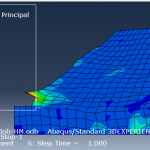
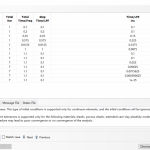
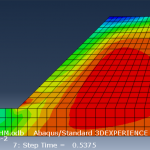
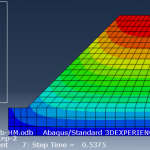
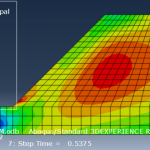
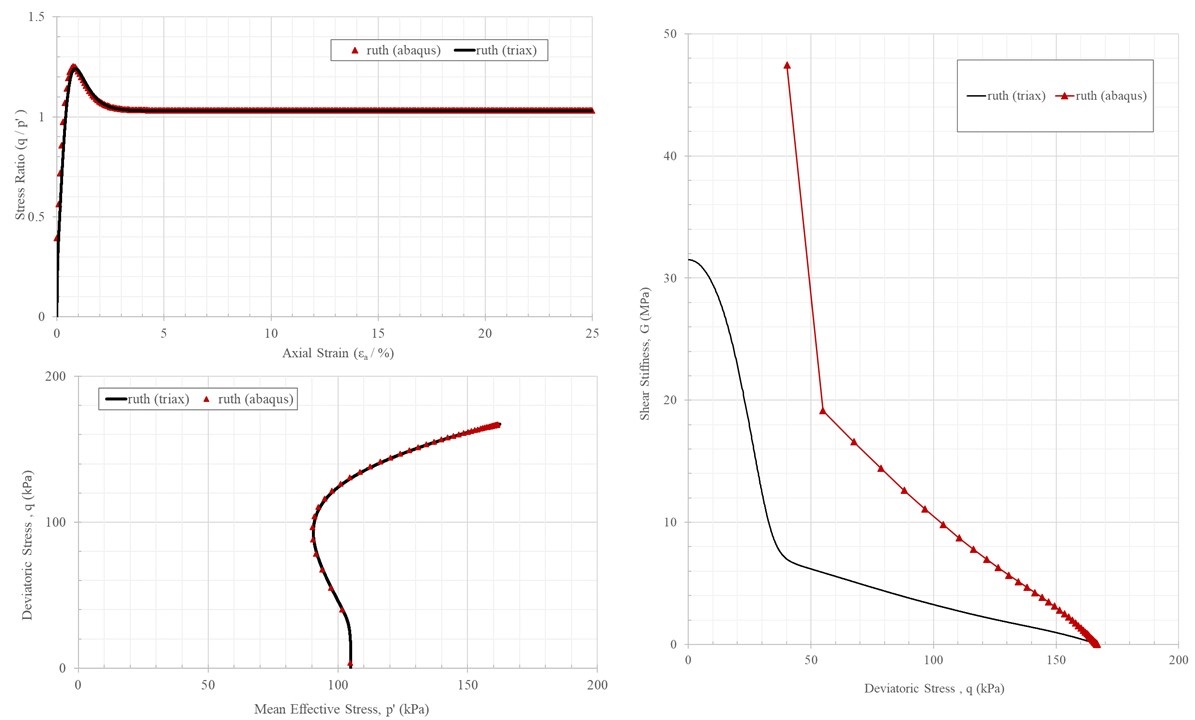



This reply may not be helpful to your question, but from the distortion shape of element in Fig.1, it looks like hourglass mode. Did you use linear brick elements with reduced integration?
Thank you for your reply. The Fig.1 shows the E field after the geostatic step. I considered your suggestion, but it does not work.
Hi Yang,
To be clear, I mean using linear quadrilateral/brick elements with reduced integration may lead to hourglass mode. I then discretized all my simulation models to elements with full integration which is more simulation expensive. In your picture, the deformation looks like hourglass mode occurs but I am not 100% sure.
Best,
Hi shen,
Thanks for your explanation. The element type I use is the CPE4. Then, I replace the step 2 which is the strength reduction with a static_general step. A very small body force was applied to the model in the static_general step, but the model is not converged.
After the geostatic step, once the force or stress changes, the model is not converged. So I wonder if the geostatic step is necessary, and non-convergence often occurs after the geostatic step. Maybe the Initial stress is not accurate enough?
Best,